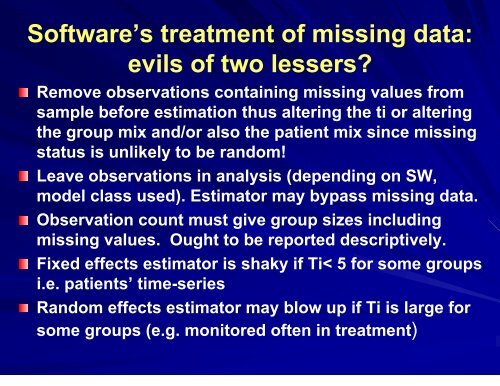Statistical Event-History Problems for Differential Diagnosis in ...
Statistical Event-History Problems for Differential Diagnosis in ...
Statistical Event-History Problems for Differential Diagnosis in ...
Create successful ePaper yourself
Turn your PDF publications into a flip-book with our unique Google optimized e-Paper software.
Software’s treatment of miss<strong>in</strong>g data:<br />
evils of two lessers?<br />
Remove observations conta<strong>in</strong><strong>in</strong>g miss<strong>in</strong>g values from<br />
sample be<strong>for</strong>e estimation thus alter<strong>in</strong>g the ti or alter<strong>in</strong>g<br />
the group mix and/or also the patient mix s<strong>in</strong>ce miss<strong>in</strong>g<br />
status is unlikely to be random!<br />
Leave observations <strong>in</strong> analysis (depend<strong>in</strong>g on SW,<br />
model class used). Estimator may bypass miss<strong>in</strong>g data.<br />
Observation count must give group sizes <strong>in</strong>clud<strong>in</strong>g<br />
miss<strong>in</strong>g values. Ought to be reported descriptively.<br />
Fixed effects estimator is shaky if Ti< 5 <strong>for</strong> some groups<br />
i.e. patients’ time-series<br />
Random effects estimator may blow up if Ti is large <strong>for</strong><br />
some groups (e.g. monitored often <strong>in</strong> treatment)


